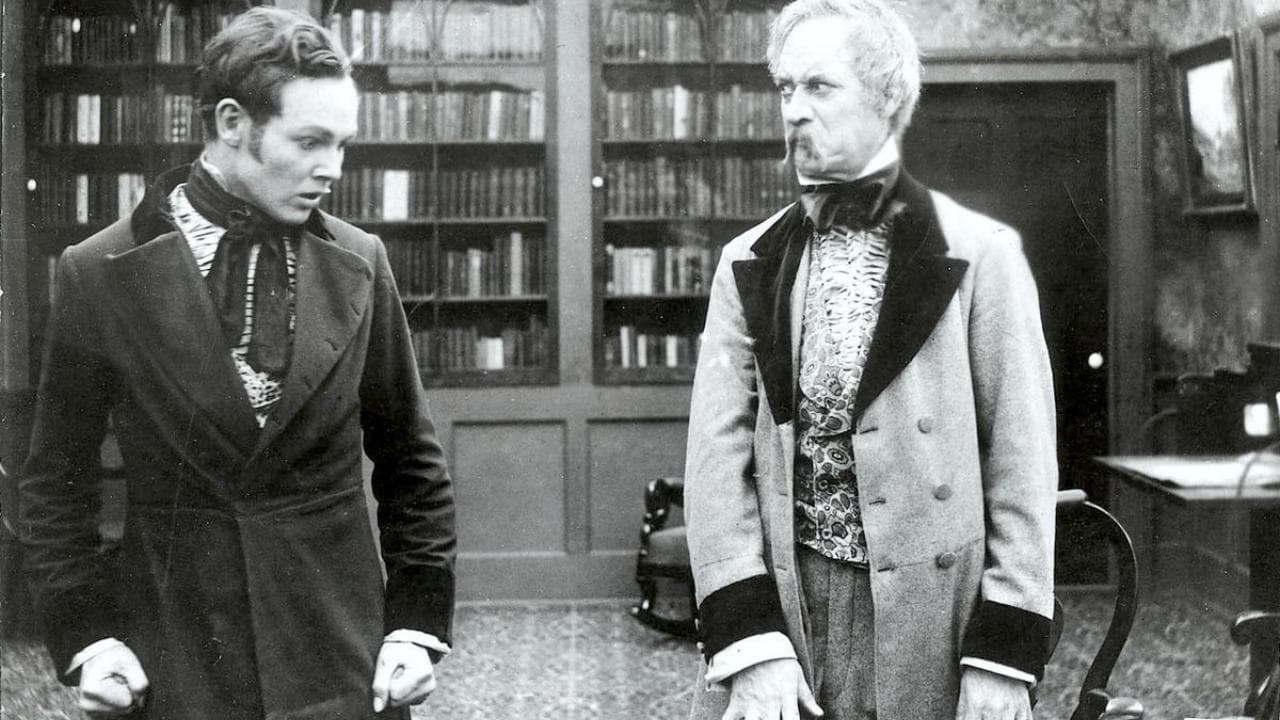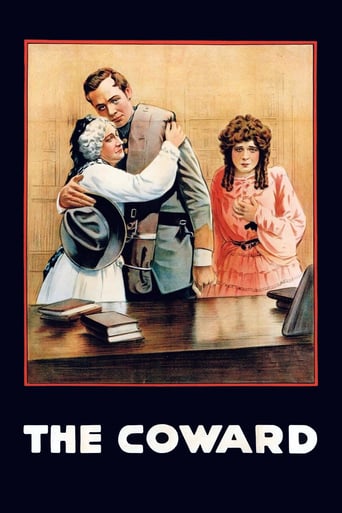



Most undeservingly overhyped movie of all time??
Highly Overrated But Still Good
Great movie! If you want to be entertained and have a few good laughs, see this movie. The music is also very good,
View MoreOne of the best movies of the year! Incredible from the beginning to the end.
View MoreCharles Ray's first picture at Triangle with producer Thomas Ince, The Coward (1915), today seems trite and badly overacted despite its star-making status at the time. Frank Keenan (made up to look like a human gargoyle, especially in close-ups) as Colonel Jefferson Winslow volunteers both himself and his son in the cause of the Confederacy, but he is rejected because of his age. His son, played by Ray, is in love and painfully aware of his own cowardice, only enlisting as his father points a gun at him. During sentry duty, he panics and runs home.Old Colonel Winslow takes the son's place to redeem the family honor. However, when the Yankees occupy Winslow's home town and the son overhears their military plans, he makes a risky escape back to the Confederate camp to inform the general. It is the father's own bullet which fells the son as he passes through the lines, and the general must unite the reluctant father with his son who has made victory possible.Much of the insight into the inner experience and the emotion of the "soul-fight" (as critics referred to this aspect of the drama at the time) was achieved through camera angle and cutting. The battle scenes include none of the principles and appear to have been shot separately; the negative cost of the five or six reel production was $17,922.Ray recalled that the role was so unsympathetic that no one wanted to be cast in the unheroic part, but he begged for it. "I worked so hard over that Coward that he just couldn't help being real. I dreamed him and lived him and for the time being, I was not Charles Ray—I was that boy." The match of the stage veteran Keenan with the youthful Ray, who actually had more screen experience, was so popular that the pair reappeared in subsequent father-son pairings.Ray's success was to make him type-cast; he could not leave a certain type of role because of adverse public reaction. As he noted, "After that, I played cowards for a year. People in this business seem to think that because you make a hit in a character once, you should never stop playing it." He typically played a young weakling or a deserter, who is redeemed but often dies in the process. William S. Hart's characters for Ince followed a similar trajectory, but begin at a different point: the strong, mature man who has taken the wrong way in life and must find his way back. The Coward also became one of the best-remembered examples of the Civil War cycle in Thomas Ince's productions, as I outline in my Ince biography.
View MoreIn 1861, the outbreak of the U.S. Civil War, Virginia's young men sign up by the hundreds to fight for the Confederacy. Plantation owner Frank Keenan (as Jefferson Beverly Winslow) wants to fight alongside handsome son Charles Ray (as Frank Winslow). Mr. Keenan is rejected as too old, but expects his son will enlist. Not so fast. Overcome with fear and dread, Mr. Ray gets cold feet at the recruiting station. Yes, he is "The Coward". So, disgraced war veteran father Keenan signs Ray up at gunpoint!While on "picket duty" patrol, Ray is startled by wild animals, and goes AWOL. Running home to stately "Winslow Hall", he is comforted by gentle-mother Gertrude Claire (as Betty) and the family's domesticated slaves. When papa Keenan finds out his son has deserted the Confederate Army, he flies into a rage, exclaiming, "Why was I ever born to be the father of a coward?" while Ray shamefully sobs. Later, when Yankee soldiers invade his home, Ray gets a second chance to prove his mettle...With D.W. Griffith's "The Birth of a Nation" (released earlier in 1915) setting box offices on fire, this shorter Civil War epic was made to order; it also resembled Griffith's "The Battle" (1911) and others. An acclaimed stage actor, Frank Kennan had his name above co-star Charles Ray. Both men became screen stars with "The Coward" - but Ray quickly shot past his illustrious elder. Ray's performance in "The Coward" is excellent, and was recalled as an example of the decade's best acting (it still is).Keenan (grandfather of character actor Keenan Wynn), Ms. Claire, and Patricia Palmer (as Amy) show degrees of "stagy".The "Quigley Poll" of top ten money-making stars for the year 1916 (which took "The Coward" into account) debuted Keenan at #10. In 1917, Ray debuted at #8, one above Keenan, who subsequently left the poll. From then on, Ray was found in the upper half of the exhibitors' list, complied by Quigley Publications from 1915 to the present. Ray was a million-dollar super-star until pouring his fortune into his own production company, which famously flopped with "The Courtship of Miles Standish" (1923).******** The Coward (10/3/15) Thomas H. Ince : Reginald Barker ~ Charles Ray, Frank Kennan, Gertrude Claire, Margaret Gibson
View MoreAt most, this might lead you to appreciate the watershed brilliance of "The Birth of a Nation". Another 1915 feature-length film set during the American Civil War, "The Coward" is an isolated melodrama, in lieu of scope or scale, with only one or two comparatively small skirmishes, affecting, in whole, neither interest or controversy. Most similar between the two films is probably their theatricality--the staginess of camera placement and missing walls, the way of storytelling and the histrionic acting. There are a few rather nice looking shots in this film, actually, but the entire picture is poorly crafted and choppy at times. The story of a father forcing his coward son at gunpoint to enlist for the Confederate army--and so on--is forgettable. Perhaps suitable on stage, Frank Keenan's rigor mortis stances and facial contouring are so out of place its laughable. Poor commemoration for Ince.(Note: The print I saw is in poor shape in parts--possibly causing some of the choppiness.)
View MoreThe DVD "Civil War Films of the Silent Era" has three Thomas Ince productions on it-- the highly successful 1915 feature The Coward, starring Charles Ray and Frank Keenan (Keenan Wynn's grandfather, incidentally, and at times you can definitely tell), plus two shorts from 1913, Granddad and The Drummer of the 8th. The former is directed by Reginald Barker, who I daresay is the only director most of us could associate with Triangle (he directed The Italian, Civilization, several Hart westerns, etc.)It's pretty tough not to compare a 1915 film about the South to a certain D.W. Griffith film, and on the evidence Barker was highly capable and in some ways more fluid in his storytelling than Griffith, but didn't have Griffith's eye for the iconic actorly gesture that summed up character in a flash. There's nothing flashy about the on-screen agonizing that represents the delineation of character here, which is well acted for the period but takes literally a third of the movie to get across a fairly simple setup-- Dad (Keenan) is a proud Suthanah and gennelmun, Son (Ray) is a weakling who runs away from the enlisting office, and Dad orders Son to sign up and remembah that he is a Winslow, suh. There's a lot of knuckle-biting to get to that point.Once Ray deserts the movie picks up noticeably, and the action scenes are very nicely handled-- the manner in which Ray eludes capture in his own house is ingenious and nicely in character for someone who was a boy in the home, for instance. Watching it there are enough echoes of The General-- the enlistment opening, spying from beneath a table, etc.-- that you have to think that Keaton was drawing on memories of it, even if unconsciously. The battle scenes are fairly brief but impressively scaled (especially next to those in the shorts-- it's much like the difference in scale between the battle in The Battle of Elderbush Gulch and The Birth).But perhaps most interesting is what's missing-- The Birth's racial attitudes. This is much closer to Gone With the Wind's benevolent-paternalist view of master-slave relations, and while a definite air of Old South nostalgia/apologia fills the film, it feels right, for instance, that when Ray first sneaks into his home as a deserter, it's the servants who probably really raised him who take him in and try to ease the discovery of his action by his parents. (Of course, they may also have approved of desertion from the Confederate army...)
View More